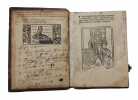"SJÆLLANDSKE LOV - THE WORLD'S FIRST FACSIMILE?
Hær begynnes then Zelands low paa ræt dansk och er skifft i sijw bøgher och hwer bogh haffuer sith register oc ær wel offuer seeth och rætthelige corrigeret. (Kolofon: Oc nu gien Prentet udi Kiøbenhaffn Anno 1576 lige effter den Gamle Lowbog...).
(Colophon:) Kiøbenhaffn (Copenhagen), Matz Wingaardt, 1576. 4to. Pragtfuldt samtidigt hellæderbind af kalveskind over træ med skråtskårne kanter og 2 lukkestroppe med messingbeslag (det ene hængsel løst), antageligt udført af en dansk bogbinder. 3 ophøjede ægte bind på ryggen og med blindtrykte stregbordurer. Permer med dobbelte stregrammer og 2 brede rammer udført med ruller og stempler. Midtfelterne med stort pladetrykt billede af Justitia, på bagpermen et billede af Justinian ?. Kapitæler med mindre reparationer. Titelbladet med en træsnit illustration af den danske konge med rigsvåbnet. Kolofon med Gotfred af Ghemens trykkermærke i træsnit. 111 unummerede blade. Indersiden af forpermen har notater i gl. hænder vedrørende bogens indhold. Fra Oscar Wandels bogsamling med hans exlibris. Da bogen ikke er ombundet foreligger den her i dens opsrindelige størrelse med pænt brede marginer. Få spredte brunpletter. Nogle blade med en svag skjold nederst på siderne. De første 6 blade (incl. titelbladet) er noget restaurerede med senere omkantning. Titelbladet har en smule tab af stregrammen omkring kongen, blad 2 recto har tab af et ord i nederste linie (tagher). Trykt på svært papir.
Reference : 56695
Extremely rare first printing of what is arguably the world's first facsimile, namely Mads Vingaard's 1576 reproduction of the first printing of the Law of Sealand, originally printed by Ghemen in 1505 and here re-issued in exact reproduction. This wonderful print is not merely a ""line to line, word to word""-reproduction, but a facsimile making use of the same types and exact reproductions of the woodcuts. It is generally believed that ""the first facsimile in the history of the book was a manuscript of Austrian provenance - the Goldene Bulle - reproduced in 1697 by the Frankfurt law historian Heinrich Günther Thülemeyer and Johann Friedrich Fleischer"" (from ""Imagination, Almanach"" 1986-1993, Sammelheft. 1993"" 2006). The present reproduction predates that work otherwise hailed as the first ""facsimile"" in the history of the book by more than a century!Some credit Plantin in the 17th century with being the first to produce a facsimile. This is also about a century after Mats Vingaard's facsimile of the Law of Sealand. Like the laws of Sealand and The Law of Scania, The Law of Jutland"" constitutes a law book (""Rechtsbuch"" in German) in the sense of a private collection of those common laws pertaining to inheritance, ownership, marriage, measurement of land, murder, theft, vandalism, etc. that were commonly applicable in the region.The medieval Danish regional laws possess an immense importance both linguistically and legally, and the influence is evident even today, both in the development of our legal system and of our written language. At the time of their foundation, the Danish kingdom was divided into jurisdictional areas, lands, that in turn were divided into townships. Each land had a county council, which also served as a judicial court. It quite quickly became standard for the township court to be able to refer verdicts and rulings to the county/land council. In the 13th century, there were three main lands, namely Jutland, Sealand and Skåne. With time, these three lands came to rule over all townships, and thus, we find three ruling legal books from the 13th century, namely the three earliest Danish law books - Jyske Lov, the Sealandic Laws, and Skånske Lov. They were all printed for the first time in 1505 and 1505 respectively. It is not until 1683 (with ""Danske Lov"") that Denmark gets a law that covers the entire kingdom. The 1576 facsimile is scarce and Thesaurus estimates that only ab. 10 copies still exist on private hands.
Bookseller's contact details
Herman H. J. Lynge & Son
William Schneider
Silkegade 11
1113 Copenhagen
Denmark
+45 33 155 335
Payment mode
Sale conditions
All items may be returned for a full refund for any reason within 14 days of receipt.
 Write to the booksellers
Write to the booksellers




